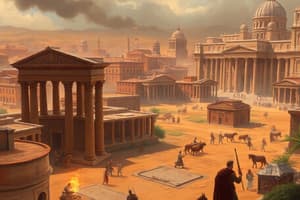Podcast
Questions and Answers
¿Qué papel jugaron las invasiones bárbaras en la caída del Imperio Romano Occidental?
¿Qué papel jugaron las invasiones bárbaras en la caída del Imperio Romano Occidental?
Las invasiones bárbaras fueron a menudo impulsadas localmente, con los bárbaros aprovechando oportunidades para obtener tierras, recursos y poder.
¿Cómo contribuyó la inestabilidad política en el Imperio Romano a su declive?
¿Cómo contribuyó la inestabilidad política en el Imperio Romano a su declive?
La inestabilidad política se debió a la pérdida de influencia del Senado Romano, la desconexión entre el pueblo y los líderes, y la corrupción e ineficiencia del sistema burocrático.
¿Por qué se considera el año 410 d.C. como el punto de inflexión para el Imperio Romano Occidental?
¿Por qué se considera el año 410 d.C. como el punto de inflexión para el Imperio Romano Occidental?
El saqueo de Roma por los visigodos en 410 d.C. marcó el fin de la invencibilidad de la ciudad y señaló el declive del imperio.
¿Cómo influyeron los problemas económicos en la inestabilidad política del Imperio Romano?
¿Cómo influyeron los problemas económicos en la inestabilidad política del Imperio Romano?
¿Cuál fue el legado del Imperio Romano Occidental a pesar de su caída?
¿Cuál fue el legado del Imperio Romano Occidental a pesar de su caída?
¿Qué factores contribuyeron a la caída del Imperio Romano Occidental?
¿Qué factores contribuyeron a la caída del Imperio Romano Occidental?
¿Cómo afectó la gestión ineficaz de los líderes del Imperio Romano Occidental a su declive?
¿Cómo afectó la gestión ineficaz de los líderes del Imperio Romano Occidental a su declive?
¿Qué papel desempeñaron los cambios sociales y culturales en la caída del Imperio Romano Occidental?
¿Qué papel desempeñaron los cambios sociales y culturales en la caída del Imperio Romano Occidental?
Flashcards are hidden until you start studying
Study Notes
The Fall of the Western Roman Empire: Causes, Barbarian Invasions, and Political Instability
The Western Roman Empire, once a mighty force in world affairs, crumbled like a sandcastle washed away by the tides of history. What brought about this epic shift, and how were the forces of Barbarian invasion and political instability intertwined in this dramatic transformation?
Origins of Decline
The decline of the Western Roman Empire was a multifaceted process. Initially, the Roman Empire faced challenges like economic strain, loss of territory, and a weakened military, all of which were intensified by poor governance. With weak central leadership, the empire struggled to manage external threats while internal corruption and inefficiency rose.
Barbarian Invasions
Barbarian tribes, migrating from the north and east, saw an opportunity to expand into the Roman territories. The barbarians, such as the Visigoths, Franks, and Vandals, carried a new form of warfare: mobile, adaptable, and capable of bypassing the traditional Roman fortifications.
Their entry into the Roman Empire often began with the promise of serving as mercenaries, only to eventually overthrow their Roman employers. Barbarians were also attracted to the wealthy lands offered by the empire, and their military prowess made them formidable opponents.
Barbarian invasions were not a single, coordinated effort, but rather a series of events that unfolded over time. Invasions were often locally driven, with barbarians seizing opportunities to gain land, resources, and power, rather than a grand conspiracy against Rome.
Political Instability
The Roman Empire's political instability contributed to its decline in several ways. The Roman Senate, once a powerful force in the empire, had lost influence, and the Roman people were disconnected from their leaders. The emperors of the time often relied on military support rather than popular consent to hold their thrones.
In addition, the empire's political system relied on a large bureaucracy to govern the growing empire. When the bureaucracy became corrupted or inefficient, the system itself began to break down, leading to political instability and eventual collapse.
Economic issues also played a role in political instability. As the empire's ability to produce food and materials waned, the population became increasingly reliant on imports, making the empire vulnerable to external economic pressure.
A Tipping Point
The year 410 A.D. is often cited as the tipping point for the Western Roman Empire. In that year, the Visigoths sacked Rome, marking the end of the city's status as an invincible power. This event, along with other factors like political instability and economic decline, paved the way for the empire's ultimate fall.
The Legacy of the Western Roman Empire
The Western Roman Empire was not defeated by a single event, but rather by a complex web of issues that ultimately led to its downfall. Despite the empire's decline, its legacy lives on in the strategic and governmental systems it inspired, including the influence of the Roman legal system that permeates many modern legal systems.
The fall of the Western Roman Empire also provided a window of opportunity for the rise of new powers, such as the Byzantine Empire and the Holy Roman Empire, that would shape the course of European history. The Fall of the Western Roman Empire, Stanford University Encyclopedia of Philosophy, https://plato.stanford.edu/entries/western-roman-empire/#Collapse.
Studying That Suits You
Use AI to generate personalized quizzes and flashcards to suit your learning preferences.




